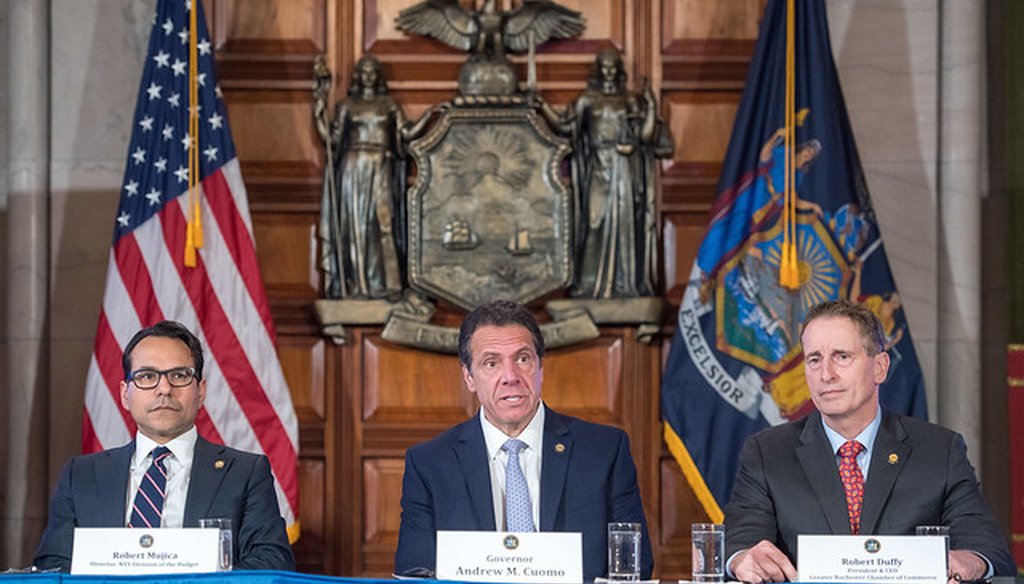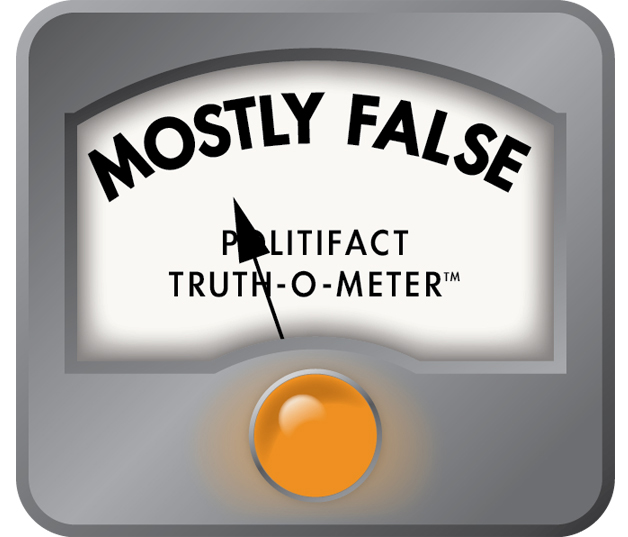Get PolitiFact in your inbox.

Gov. Andrew Cuomo, center, gives an update on the budget on March 11, 2019. At left is Budget Director Robert Mujica, at right is Greater Rochester Chamber of Commerce CEO Robert Duffy. (credit: flickr/governorandrewcuomo)
Cuomo’s claim not the case for most NY taxpayers
Gov. Andrew Cuomo’s complaints about a provision in the 2017 federal tax law have intensified in recent months. The provision caps the federal deduction for state and local tax payments at $10,000.
"As governor of the state of New York today, my top priority is repealing SALT. Period," Cuomo told reporters in March, referring to the cap on state and local tax deductions in the Tax Cuts and Jobs Act.
The effect of the $10,000 cap on SALT deductions is widespread in New York, Cuomo said.
"Fifty-two counties have average taxes of above the SALT $10,000 cap," Cuomo said at his March news conference. "Fifty-two counties will see a tax increase."
We wondered if his rhetoric around the issue is accurate. Is the problem with the cap as widespread as he said? Do 52 counties have average state and local taxes above the $10,000 cap?
Cuomo has repeated this claim several times, and a report from the Office of the State Comptroller appears to be his source. In October 2017, while changes to the tax law were under discussion but before they were passed, Comptroller Thomas DiNapoli released a report on how the changes could affect New York. One of the proposals DiNapoli’s office analyzed was the proposal in Washington to eliminate or reduce the federal deduction for state and local taxes.
"This is a big deal for our state: New Yorkers reported more than $72 billion in deductions for income and property taxes in 2015," DiNapoli wrote.
Of that total, income taxes accounted for $51.7 billion and property taxes for $20.9 billion.
The Office of Comptroller found that filers who claimed state and local tax deductions had an average deduction of more than $10,000 in 52 of New York’s 62 counties, according to its analysis of county-by-county data from the Internal Revenue Service’s Statistics of Income program from the 2015 tax year.
The most recent IRS data, released from the 2016 tax year, showed average deductions above $10,000 in 53 counties.
Featured Fact-check
We asked some tax experts about Cuomo’s claim. Several noted that many tax filers do not itemize their deductions, and that Cuomo’s claim about "average taxes above the cap" fails to convey this point.
"Only 34.8 percent of New Yorkers took the state and local tax deduction in 2016; the governor is claiming that average taxes in these counties are over $10,000 based on the taxes of a little over one-third of the population -- generally speaking, the wealthiest one-third," said Jared Walczak, a senior policy analyst at the nonpartisan Tax Foundation. Walczak found that the average state and local taxes across all filers was above $10,000 in only three counties: Westchester, New York and Nassau. Even if it’s not relevant for SALT deduction purposes, filers who don’t itemize have state and local tax liabilities, too, so the average would be over $10,000 in a handful of other counties, such as Putnam, Rockland and Suffolk counties, Walczak said.
Tax experts also noted that averages can be skewed by a few very high earners.
"To put this in context: 81.5 percent of New York filers have an adjusted gross income of $100,000 or less, and they pay an average of $2,840 in federal income taxes. Yet the average federal income tax liability for a New York filer is $13,896, skewed upward by the highest earners," Walczak said. "Similarly, the vast majority of New York filers are well below the SALT deduction cap, and in many cases aren't deducting state and local taxes at all."
If Cuomo’s implication is that taxes will go up because of the cap on SALT, "of course, most of those people still get a tax cut because of TCJA," said Steve Wamhoff, director of federal tax policy at the left-leaning Institute of Taxation and Economic Policy.
We asked the governor’s office about the issues with his claim that 52 counties have average state and local taxes above $10,000.
"The facts remain the same: The federal government values the cap on SALT deductions at more than $600 billion over the next decade; and New Yorkers will pay $15 billion more to the federal government annually, taking more from New York than any other State," said Freeman Klopott, spokesman for the Division of Budget. "The bottom line is this is a tax increase for our state to benefit the federal government that unfairly attacks New York, which is already the top contributor to the federal government."
PolitiFact New York has fact-checked a claim that New York gives more to the federal treasury than the state gets back, and found it to be True.
In making a case to repeal the $10,000 cap on state and local tax deductions, Cuomo said that in 52 counties the average amount of state and local taxes exceeded the cap.
The latest data available, from 2016, before the new tax law was implemented, show that in 53 counties, the average state and local tax deduction was greater than $10,000, when the average is calculated using returns from filers who claimed that deduction -- not from every filer. He bases his statement on the taxes paid by about one-third of the population, generally the more affluent one-third.
Cuomo's statement contains an element of truth but ignores critical facts that would give a different impression about how severe the cap is for most New Yorkers. He makes it seem the cap's effect is more widespread than it is.
We rate his claim Mostly False.
Our Sources
Transcript: Governor Cuomo Outlines Remaining Budget Priorities, Gov. Andrew Cuomo website, March 11, 2019. Accessed April 8, 2019.
"Governor Cuomo Launches Nationwide Campaign for Tax Fairness," Gov. Andrew Cuomo website, Feb. 13, 2019. Accessed April 8, 2019.
Email conversation, Brian Butry, spokesman, Office of the State Comptroller, April 9, 2019.
Phone, email conversation, Freeman Klopott, spokesman, New York State Division of Budget, April 9, 11, 12, 2019.
Email conversation, E.J. McMahon, founder, research director, Empire Center for Public Policy, April 9, 2019.
Email conversation, Jared Walczak, senior policy analyst, Center for State Tax Policy, Tax Foundation, April 11, 2019.
Email conversation, Steve Wamhoff, director of federal tax policy, Institute on Taxation and Economic Policy, April 11, 2019.
The Proposed Framework for Federal Tax Changes: A New York Perspective, Office of the State Comptroller, October 2017. Accessed April 8, 2019.
Analysis of the SALT Act, Tax Foundation, March 11, 2019. Accessed April 8, 2019.
SOI Tax Stats - County Data - 2016, IRS.gov, Statistics of Income. Accessed April 10, 2019.
Model Estimates, Repeal of $10,000 Limit on State and Local Deductible Taxes, Tax Policy Center, Urban Institute and Brookings Institution, Sept. 24, 2018. Accessed April 11, 2019.
"Looking ahead to next year’s Tax Day," Empire Center for Public Policy, April 18, 2018. Accessed April 9, 2019.
"Many Rich Fretting About SALT Didn’t Get That Tax Break Anyway," Bloomberg News, March 26, 2019. Accessed April 10, 2019.
Browse the Truth-O-Meter
More by Jill Terreri Ramos
Cuomo’s claim not the case for most NY taxpayers
Support independent fact-checking.
Become a member!
In a world of wild talk and fake news, help us stand up for the facts.










 PolitiFact Rating:
PolitiFact Rating: 









































